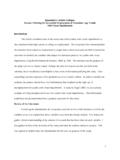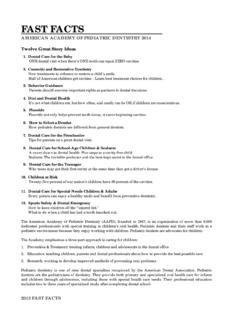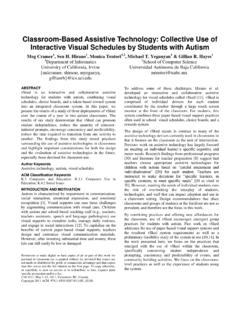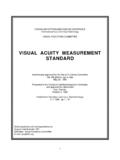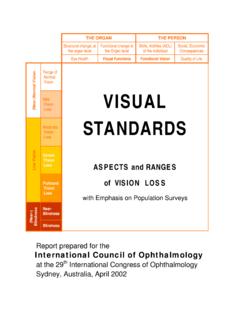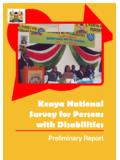Transcription of Persons with Visual Impairments and their …
1 Persons with Visual Impairments and their educational Needs in India: Use of special devices and assistive technologies Sharada Prasanna Rout1 In many societies around the globe, people with Visual Impairments comprise some of the most socially excluded groups. Though disability studies in education have recently been formally recognized, it started when the educators have resisted and spoken against the hegemony of special education, institutionalization, sheltered workshops, and social exclusion. Disability studies in education also depend on the social theories which influence the conceptualization of disability to a large extent. Now, scholars in the humanities also have been influential.
2 Today, educators around the globe are coming up with new ways of thinking about disability and educational research, policy, and practice. Since India's independence, the policy makers treat physically disabled Persons as the recipients of the state sponsored welfare schemes. Though, one cannot completely neglect the benefits of these schemes, mere welfare schemes are inadequate to facilitate the visually disabled to perform major roles as the able individuals. Therefore, the role of the state components such as the legislature, executive, and the judiciary system becomes extremely important in transforming the societal attitude towards Persons with disabilities. Within this broader framework, the paper aims to look at the concept of Visual impairment in general and the Indian understanding of the concept in particular, followed by their educational needs and various implications.
3 The central theme of the paper is to look at the significance of assistive technologies for the education of Persons with vision Impairments . In this context, some of the constitutional provisions and legislative measures have also been analyzed. It also makes an attempt to analyse various types of assistive technologies and their usage for providing a quality education to such people. Definition and Classification of Visual impairment The visually impaired is an umbrella term, used widely and understood in an educational context. This term is used to describe the group of Persons whose vision is affected by Impairments in seeing. The term refers to all the Persons whose vision disadvantage has resulted from impairment as well as disabilities.
4 In case of Persons who are completely without 1 Sharda Prasanna Rout is pursuing his from the Centre for the Study of Law and Governance, Jawaharlal Nehru University, New Delhi. He specialises in the field of governance and assistive educational policies for disabled in India. vision or who have light perception only, it is desirable to use the term blind . In all other cases of Visual defects the term visually impaired should preferably be used. For the Persons whose Visual acuity falls between 6/ 18 and 6/60 in the better eye after the best possible correction, the term low vision should be used. In context of vision defects, a variety of terms viz. totally blind, stone blind, blind, partially blind, legally blind, economically blind, visually limited, low vision, partially sighted, visually handicapped, visually impaired etc.
5 Are being used {RamaKrishna T. 2009, Armstrong 2009, }. Understanding of Visual impairment in India The most common definition and classification of disability used by the Government of India for all purposes was determined with the enactment of the Persons with Disabilities (Equal Opportunities, Protection of Rights and Full Participation) Act, 1995 (section 2). Disability has been classified into seven classes on the basis of medical definition. These classes include people with blindness, low-vision, leprosy (cured), hearing impairment , locomotor disability, mental retardation and mental illness. Out of the coverage of each of the aforesaid seven groups, the Persons with Disabilities (Equal Opportunities, Protection of Rights and Full Participation) Act, 1995 has given the following respective definitions to blindness and low-vision: Blindness refers to a condition where a person suffers from any of the following conditions namely: Total absence of sight; or Visual acuity not exceeding 6/60 or 20/200 (Snellen test) in the better eye with correcting lenses; or Limitation of the field of vision subtending an angle of 200 or worse.
6 Person with low vision means a person with impairment of Visual functioning, even after treatment or standard refractive correction but who uses, or is potentially capable of using, vision for the planning or execution of a task with appropriate assistive device. Thus, blindness in India has been classified broadly under two categories: , total blindness and low-vision. If we analyze the above mentioned definitions of the concept Visual impairment we can clearly find some practical problems. Though low vision and no-vision have been defined separately, they broadly come under the category of visually impaired. A totally visually impaired individual is quite different from a person having low vision.
7 educational Needs and Implementation As per the Constitution of India, education is as one of our fundamental rights. In our country, we earlier had the concept of special education for the disabled sector including students with Visual Impairments . However in the mid 1970s the integrated system of education has come into existence. Besides this, many non-governmental organizations with the help of the state administration are imparting traditional vocational education to the disabled. Now due to technology friendliness, the focus is being given on distance mode as the means to educate these sections of people by providing them all sort of accessibility. The government has formulated a few policies and legislations regarding the education of people with disabilities.
8 In an ideal system of inclusive education, the general education itself should make the education of disabled children as its integral part. This implies that the general classroom teachers should be equipped with skills to address the educational needs of children with disabilities with minimum or no assistance of specialist resource teachers. This calls for strengthening the pre-service general teacher preparation programme with the inclusion of adequate component of the education of disabled children in the curriculum. Therefore, inclusive education means creating effective classrooms where the educational needs of all children are addressed irrespective of ability or disability.
9 Most people feel that educating a child with disability in general school is inclusion but it can be treated as total inclusion only when the general classroom teachers take most of the responsibilities for the education of these children. If the disabled child's needs are taken care of, only by a specialist teacher in the general school, it is not total inclusion {Mukhopadhyay, S. and Mani, 1999, Ramakrishna T. 2009}. Access involves much more than providing ramps. Access is also the key element of inclusion, which involves much more than placement in a particular setting. The relationship of access and inclusion may not be obvious to individuals who are not familiar with the educational and social impact of a vision loss.
10 Placing a student with a Visual impairment in a regular classroom does not necessarily provide access and the student is not necessarily taken into consideration. A student with a Visual impairment , who does not have access to social and physical information because of Visual impairment , is not included, regardless of the physical setting. Students with Visual Impairments will not be included unless their unique educational needs for access are addressed by specially trained personnel in appropriate environments and unless these students are provided with equal access to core and specialized curricula through appropriate specialized books, materials and equipments {Petty, 2012}. It is important to remember that educational goals for students with Visual Impairments are essentially the same as those for all students.


